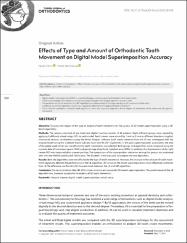| dc.contributor.author | Camcı, Hasan | |
| dc.contributor.author | Salmanpour, Farhad | |
| dc.date.accessioned | 2022-05-13T07:29:08Z | |
| dc.date.available | 2022-05-13T07:29:08Z | |
| dc.date.issued | 2021 | en_US |
| dc.identifier.citation | Camcı, H., & Salmanpour, F. (2021). Effects of Type and Amount of Orthodontic Tooth Movement on Digital Model Superimposition Accuracy. Turk J Orthod, 34(4), 220-226. | en_US |
| dc.identifier.issn | 2148-9505 | |
| dc.identifier.issn | 2528-9659 | |
| dc.identifier.uri | https://doi.org/10.5152/TurkJOrthod.2020.20146 | |
| dc.identifier.uri | https://hdl.handle.net/20.500.12933/997 | |
| dc.description.abstract | Objective: To assess the impact of type or amount of tooth movement on the success of 3D model superimposition by using two different algorithms.
Methods: The sample consisted of pre-treatment digital maxillary models of forty patients. Eight different groups were created by applying 8 different virtual setups to each model. Teeth crowns were moved 1mm or 2mm in different directions (sagittal, transversal, vertical, combination) using the Ortho Analyzer software. Each model obtained from the virtual setup was overlapped with the original model using the landmark-based (LB) and local-best-fit (LBF) algorithms. In the post-superimposition assessment, the area of the palate vault which was not affected by teeth movements was selected. Both groups and algorithms were compared using RMS (root mean square) and PMA (percentage of perfectly matched areas) numeric data. In addition, the displacement of the right canine (RC) was measured after superimposition. The comparison of the superposition outcomes among the groups was evaluated with one-way ANOVA and Kruskal Wallis. The student t-test was used to compare two algorithms.
Results: Both algorithms were not affected by the type of tooth movement. However, the increase in the amount of tooth movement negatively affected the performance of the LB algorithm. LBF achieved the model superimpositions more effectively and faster than LB. No difference was found in RC measurements between the LB and LBF algorithms.
Conclusion: The results indicate that LBF offers more sensitive and successful 3D superimposition models. The performance of the LB algorithm was, however, acceptable for analysis of 3D teeth movement. | en_US |
| dc.language.iso | eng | en_US |
| dc.publisher | AVES Yayıncılık | en_US |
| dc.relation.isversionof | 10.5152/TurkJOrthod.2020.20146 | en_US |
| dc.rights | info:eu-repo/semantics/openAccess | en_US |
| dc.subject | Intraoral scanner | en_US |
| dc.subject | Digital model superimposition | en_US |
| dc.subject | Virtual setup | en_US |
| dc.title | Effects of Type and Amount of Orthodontic Tooth Movement on Digital Model Superimposition Accuracy | en_US |
| dc.type | article | en_US |
| dc.authorid | 0000-0003-0824-4192 | en_US |
| dc.authorid | 0000-0003-1006-9792 | en_US |
| dc.department | AFSÜ, Diş Hekimliği Fakültesi, Klinik Bilimler Bölümü | en_US |
| dc.contributor.institutionauthor | Camcı, Hasan | |
| dc.contributor.institutionauthor | Salmanpour, Farhad | |
| dc.identifier.volume | 34 | en_US |
| dc.identifier.issue | 4 | en_US |
| dc.identifier.startpage | 220 | en_US |
| dc.identifier.endpage | 226 | en_US |
| dc.relation.journal | Turkish Journal Of Orthodontics | en_US |
| dc.relation.publicationcategory | Makale - Uluslararası Hakemli Dergi - Kurum Öğretim Elemanı | en_US |
















